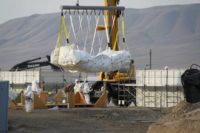Electrical Power
Bechtel Team to Build $3B-$6B Nuclear Test Reactor in Idaho

A 3D representation of the test reactor core and control rods. Image: Courtesy of Bechtel
The U.S. Energy Dept. is set to build at its Idaho Falls, Idaho, nuclear research site a test reactor to support research and development of new nuclear energy technologies, the agency’s nuclear energy office said by tweet on Nov. 19. Known as the Versatile Test Reactor, or VTR, the project will cost from $3 billion to $6 billion, with design and construction by a Bechtel-led team.
Battelle Energy Alliance, which operates the Idaho National Laboratory site, is negotiating with Bechtel National, along with team members TerraPower and GE Hitachi Nuclear Energy.
According to DOE, the VTR will foster experiments with much higher neutron energy and flux compared to the nation’s existing 35 research reactors, which would help develop advanced nuclear fuel for future nuclear power plants in the U.S.
The announcement follows a review of submissions by industry teams in response to a request for proposals issued earlier this year, says Battelle. Members of other proposing teams were not identified, but DOE has said experts from five other agency research labs, 19 universities and nine “industry partners” are developing VTR conceptual designs, cost estimates and schedules.
Battelle received “multiple high-quality proposals” from industry, which shows support to build a fast-spectrum neutron testing reactor, said lab director Mark Peters. Bechtel will bring design and construction expertise to the project, he says. The firm is leading construction of a high-level radioactive waste vitrification plant at DOE's Hanford nuclear cleanup site and is working on nuclear power plants in Georgia and in the U.K.
“We have repeatedly heard from industry and other stakeholders that the U.S. needs a fast neutron scientific user facility to maintain our global leadership in nuclear energy," Rita Baranwal, assistant DOE secretary for nuclear said in a statement.
Peters is set to become Battelle's executive vice president for laboratory operations next month, working with all national labs that Battelle manages. Named to succeed him is John Wagner, formerly an associate Idaho laboratory director for nuclear science and technology.
Congress allotted $95 million to support advanced reactor research and development. The VTR program was launched in 2018 in response to requests from U.S. companies investing in and developing advanced reactors that require different testing facilities than the commercial nuclear power technology that's in use today. But according to one report, the VTR project has faced some recent congressional funding controversies and cuts.
A draft environmental impact statement for the test reactor will be released in mid-December. The final is due in 2021, followed by a record of decision to finalize the site selection. The Oak Ridge National Laboratory in Tennessee is a potential alternative.
Plans call for building the reactor by the end of 2025, with fuel to power VTR to be produced at either the Idaho lab or at DOE’s Savannah River Site in South Carolina.
if built, the VTR will join only a handful of sodium-cooled fast reactors that are currently operating or planned, based on designs and technologies developed and demonstrated in other countries.
“Advanced reactors hold great promise, but their fuels and materials need proper testing before they can be licensed and used in energy-producing reactors,” Barbara Rusinko, president of Bechtel’s Nuclear, Security & Environmental global business unit, noted previously. The VTR is “extremely important for the science community, industry, regulators and the future of nuclear energy research.”
Cutting Nuke Construction Costs
While DOE is looking at advanced technologies, the Massachusetts Institute of Technology is analyzing how to help developers of new nuclear power plants use existing technology to lower design and construction costs
Bringing down costs could be an important step toward encouraging new plants as part of the energy transformation in the U.S. and globally, says a new university study published in the journal Joule.
Led by Jessika Trancik, an associate professor of energy studies, and Jacopo Buongiorno, associate professor of nuclear science and engineering, the study team says that building new plants based on existing design actually costs more, not less, than building the initial plant.
The team looked at 50 years of nuclear plant construction cost data.
Last-minute design changes based on conditions at the construction site and the associated delays caused much of the excess cost, the team said, which suggested that more components could be built offsite under controlled factory conditions to cut costs.
Those so-called “soft costs” could reduce overall project expense costs if considered in the design phase. Substituting new kinds of concrete could reduce the overall amount of material needed and cut construction time and costs, they said.
They also suggested rather than building huge nuclear plants, that use be stepped up of offsite manufacturing approaches and smaller modular reactors that could be self-contained and delivered to the final site with the fuel already installed.
"We need to be rethinking our approach to engineering design," said Trancik. "There is a path forward to increasing resilience that involves understanding the mechanisms behind why costs increased in the first place. But it's not going to happen without a concerted effort and without being informed by modeling that accounts for these ballooning soft costs."





